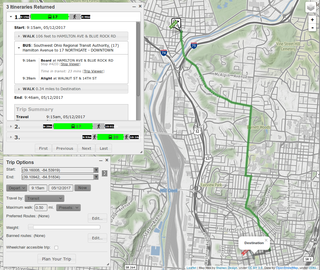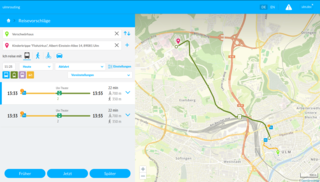Related Research Articles

Sustrans is a United Kingdom-based walking, wheeling and cycling charity, and the custodian of the National Cycle Network.

The National Public Transport Access Node (NaPTAN) database is a UK nationwide system for uniquely identifying all the points of access to public transport in the UK. The dataset is closely associated with the National Public Transport Gazetteer.
GXL is designed to be a standard exchange format for graphs. GXL is an extensible markup language (XML) sublanguage and the syntax is given by an XML document type definition (DTD). This exchange format offers an adaptable and flexible means to support interoperability between graph-based tools.
The Integrated Transport Network (ITN) is a dataset containing details of Great Britain's transport network. Produced by Ordnance Survey – the national mapping agency of Great Britain – it forms part of the OS MasterMap suite of products.

The Transport Direct Programme was a division of the UK Department for Transport (DfT) to develop standards, data and better information technology systems to support public transport. It developed and operates the Transport Direct Portal which is a public facing multi-modal journey planner. It also supports the creation and management of comprehensive databases of all public transport movements in the United Kingdom with Traveline. During 2010 two key datasets were released as Open Data and published on www.data.gov.uk.
Geospatial metadata is a type of metadata applicable to geographic data and information. Such objects may be stored in a geographic information system (GIS) or may simply be documents, data-sets, images or other objects, services, or related items that exist in some other native environment but whose features may be appropriate to describe in a (geographic) metadata catalog.
TransXChange is a UK national XML based data standard for the interchange of bus route and timetable information between bus operators, the Vehicle and Operator Services Agency, local authorities and passenger transport executives, and others involved in the provision of passenger information.
The Standard Interface for Real-time Information or SIRI is an XML protocol to allow distributed computers to exchange real-time information about public transport services and vehicles.
Transmodel is the CEN European Reference Data Model for Public Transport Information; it provides a conceptual model of common public transport concepts and data structures that can be used to build many different kinds of public transport information system, including for timetabling, fares, operational management, real time data, journey planning etc.
IFOPT is a CEN Technical Specification that provides a Reference Data Model for describing the main fixed objects required for public access to Public transport, that is to say Transportation hubs. Such a model is a fundamental component of the modern Public transport information systems needed both to operate Public transport and to inform passengers about services.

A journey planner, trip planner, or route planner is a specialized search engine used to find an optimal means of travelling between two or more given locations, sometimes using more than one transport mode. Searches may be optimized on different criteria, for example fastest, shortest, fewest changes, cheapest. They may be constrained, for example, to leave or arrive at a certain time, to avoid certain waypoints, etc. A single journey may use a sequence of several modes of transport, meaning the system may know about public transport services as well as transport networks for private transportation. Trip planning or journey planning is sometimes distinguished from route planning, which is typically thought of as using private modes of transportation such as cycling, driving, or walking, normally using a single mode at a time. Trip or journey planning, in contrast, would make use of at least one public transport mode which operates according to published schedules; given that public transport services only depart at specific times, an algorithm must therefore not only find a path to a destination, but seek to optimize it so as to minimize the waiting time incurred for each leg. In European Standards such as Transmodel, trip planning is used specifically to describe the planning of a route for a passenger, to avoid confusion with the completely separate process of planning the operational journeys to be made by public transport vehicles on which such trips are made.

The Transport Direct Portal was a distributed Internet-based multi-modal journey planner providing information for travel in England, Wales and Scotland. It was managed by Transport Direct, a division of the Department for Transport. It was launched in 2004 and was operated by a consortium led by Atos and later enhanced to include a cycle journey planning function. The closure of the portal was announced in September 2014 "Closure of the Transport Direct website"(PDF). Archived from the original(PDF) on 12 September 2014. and the portal closed on 30 September 2014.

The Ordnance Survey (OS) is the national mapping agency for Great Britain. The agency's name indicates its original military purpose, which was to map Scotland in the wake of the Jacobite rising of 1745. There was also a more general and nationwide need in light of the potential threat of invasion during the Napoleonic Wars. Since 1 April 2015, the Ordnance Survey has operated as Ordnance Survey Ltd, a government-owned company, 100% in public ownership. The Ordnance Survey Board remains accountable to the Secretary of State for Science, Innovation and Technology. It was also a member of the Public Data Group.

Traveline is a public transport route planner service provided by a partnership between local authorities and transport operators in the UK to provide impartial and comprehensive information about public transport which has operated since 2000. It prepares comprehensive public transport data for the UK and provides a number of regional public transport journey planners.

GTFS, which stands for General Transit Feed Specification or (originally) Google Transit Feed Specification, defines a common format for public transportation schedules and associated geographic information. GTFS contains only static or scheduled information about public transport services, and is sometimes known as GTFS Static to distinguish it from the GTFS Realtime extension, which defines how information on the realtime status of services can be shared.

CycleStreets is a not-for-profit United Kingdom organisation that provides a free-to-use national cycle journey planner for the United Kingdom. The planner uses OpenStreetMap data for routing, Shuttle Radar Topography Mission for height data and official postcode data. It was launched in March 2009 and by January 2010 had planned 100,000 journeys. As of August 2015, the site has planned over 45 million itineraries. It was 'Highly Commended' at the 2009 ACT Travelwise awards. It provides worldwide routing using OpenStreetMap data.
Crown Copyright has been a long-standing copyright protection applied to official works, and at times artistic works, produced under royal or official supervision. In 2006, The Guardian newspaper's Technology section began a "Free Our Data" campaign, calling for data gathered by authorities at public expense to be made freely available for reuse by individuals. In 2010 with the creation of the Open Government Licence and the Data.gov.uk site it appeared that the campaign had been mostly successful, and since 2013 the UK has been consistently named one of the leaders in the open data space.
NeTEx is the CEN Technical standard for exchanging Public Transport Information as XML documents. It provides a W3C XML schema based on the Transmodel abstract model of common public transport concepts and data structures and can be used to exchange many different kinds of data between passenger information systems, including data describing for stops, facilities, timetabling and fares. Such data can be used by both operational management systems and customer facing systems for journey planning etc.
References
- ↑ "schema targetNamespace="http://www.cyclenetxchange.org.uk/cnm"". Department for Transport. Retrieved 28 March 2010.